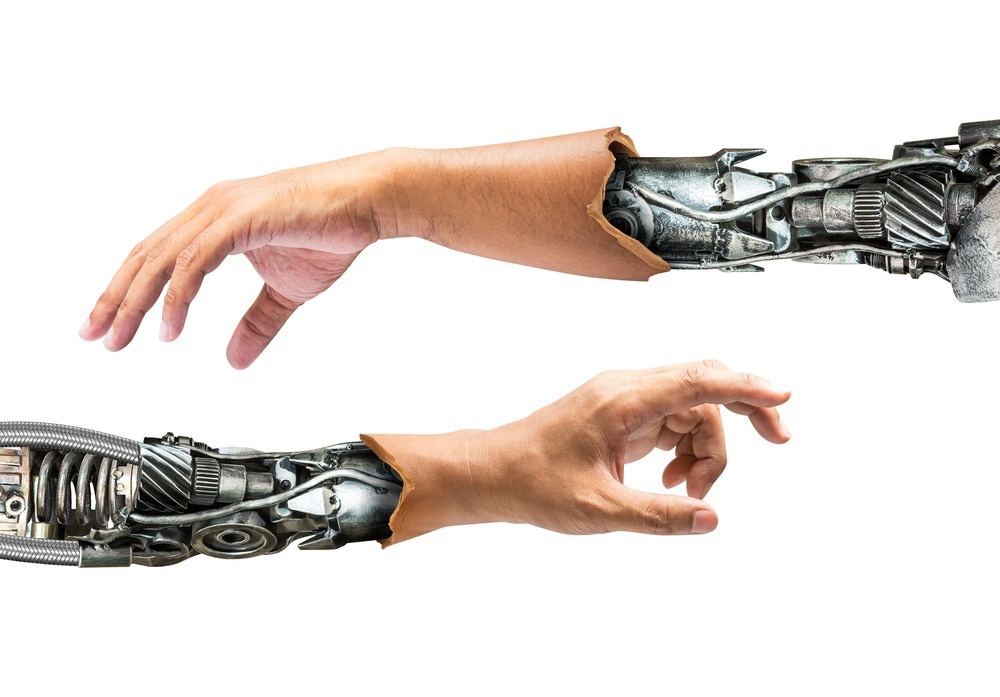Self-healable ionic sensing materials with fatigue resistance are imperative in robotics and soft electronics for extended service life. The existing artificial ionic skins with self-healing capacity were prepared by network reconfiguration, constituting low-energy amorphous polymer chains. Consequently, these materials suffer from a low fatigue threshold and are susceptible to crack propagation.

Study: Fatigue-free artificial ionic skin toughened by self-healable elastic nanomesh. Image Credit: fotoslaz/Shutterstock.com
In an article published in the journal Nature Communications, a self-healable, fatigue-free hybrid ionic skin was engineered. Ruggedness was imparted by incorporating an elastic nanomesh that was a complex network of nanofibers. Thus, the engineered ionic skin mimicked the human skin with a repairable interwoven structure based on nanofibers.
The designed hybrid ionic skin exhibited a fatigue threshold of 2950 joules per square meter while conserving stretchability, skin-like compliance, and strain adaptive stiffening behavior. The nanofibers in the material endowed the ionic matrix with moisture breathing capacity due to the induced tension, leading to a gauge factor of 66.8, which was higher than the existing artificial ionic skins. The present concept created a new path toward durable ion-conducting materials that mimicked the incomparable combinatory properties of human skin.
Integrating Nanofibers into Artificial Skin
Human skin is a multifunctional organ that is self-healing and protective with good sensing capacity. Various artificial skins were developed based on the properties and functionalities approximating those of natural skin. To this end, stretchability, conductivity, toughness, softness, healing ability, and durability are desirable in designing materials for soft robotics and human-machine interface applications.
Although self-healing capacity in these materials permits a long service life, their resistance against crack propagation during high fatigue loads further begets robustness in them. Incorporating physical crosslinks into the ion-conducting network causes chain rearrangement leading to network reconfiguration.
The ion-rich nanofibrous yet repairable structure of human skin reconciles the interchange between fatigue resistance and healing capacity, defined by a soft interwoven elastic matrix enveloping the stiff collagen fibril scaffold. The healing of human skin is based on dermal fibroblasts and repairing the crack tip at the collagen nanofibrils imparting high fracture toughness. Thus, the human skin can withstand tear fractures and deformations like muscles.
Nanofibers have diameters between 1 nanometer and 1 micrometer and are made from synthetic or natural materials. Nanofibers are commonly obtained via the electrospinning technique and resemble the natural extracellular matrix (ECM). The polymer-based nanofibers have a large surface area-to-volume ratio, high porosity, appreciable mechanical strength, and flexibility.
These properties of nanofibers have a significant effect on cell adhesion, proliferation, and differentiation, as reported in previous studies. Hence matrices based on nanofibers are explored as scaffolds in tissue engineering.
Nanofiber Reinforced Artificial Ionic Skin
In the present work, a high-energy, elastic, and self-healable nanomesh scaffold was embedded into another self-healable soft ionic matrix to design an artificial sensing ionic skin. This hybrid structure showed high fracture energy of 16.3 kilojoules per square meter, fatigue threshold of 2950 joules per square meter, 680% stretchability, and 67.5 megapascals of strain-stiffening response.
The tension-induced rearrangement of nanofibers caused reversible moisture breathing of the hygroscopic ionic matrix and led to a gauge factor of 66.8 (higher than the existing artificial skin materials) for the ionic conductors that are intrinsically stretchable.
Moreover, such hybrid ionic skin based on nanofibers had a few intriguing properties that mimicked the natural human skin, including self-healing efficiency of up to 85%, modulus of approximately 1.8 megapascals, 37 times enhanced strain-adaptive stiffness, 0.11 siemens per centimeter of ionic conductivity, and superior strain sensation. The prepared hybrid ionic skin was adhesive, transparent, and ambiently stable.
Thus, the reported artificial ionic skin resembled the human skin in terms of sensing and mechanical properties and had potential applications in durable sensors for utilization in human-machine interfaces and wearable electronics.
Conclusion
To conclude, transparent hybrid ionic skin based on nanofibers was designed using elastic polyurethane (PU) nanomesh, composed of a network of nanofibers with self-healing capacity and a supramolecular ionic matrix with a high modulus ratio.
The hybrid ionic skin was endowed with desirable properties, including softness (modulus approximately 1.8 megapascals), self-healing capacity (up to 85%), stretchability (680%), fatigue resistance (approximately 2950 joules per square meters), and strain-adaptive stiffening (37 times enhanced stiffness).
The high gauge factor of 66.8, which is the strain-sensing parameter, was due to the induced tension that led to a rearrangement of nanofiber’s alignment resulting in a reversible moisture breathing effect in a hygroscopic ionic matrix driven by water-sensitive ionic complexations.
In concurrence with its adhesiveness, transparency, and stability at room temperature, the designed ionic skin demonstrated its potential as a durable sensor with high sensitivity and applicability in wearable electronics.
Reference
Wang, J., Wu, B., Wei, P., Sun, S., Wu, P. (2022) Fatigue-free artificial ionic skin toughened by self-healable elastic nanomesh. Nature Communication 13, 4411. https://www.nature.com/articles/s41467-022-32140-3
Disclaimer: The views expressed here are those of the author expressed in their private capacity and do not necessarily represent the views of AZoM.com Limited T/A AZoNetwork the owner and operator of this website. This disclaimer forms part of the Terms and conditions of use of this website.